Analyzing Factors of Intimate Partner Violence Among Women in Uganda
VerifiedAdded on 2023/06/07
|6
|1815
|101
Report
AI Summary
This report investigates the factors associated with the prevalence and correlation of intimate partner violence (IPV) among women aged 15-49 in Central Uganda. Drawing on data from the 2016 Uganda Demographic Health Survey (UDHS), the study examines the relationships between education level, marital status, residence, decision-making power, and occupation with the experience of IPV. The research aims to address the gap in systematic research on IPV in Sub-Saharan Africa, test the generalizability of Western-developed theories in a non-Western context, and inform the development of effective intervention programs and government policies for women in Uganda. The study hypothesizes that educated women, women in rural areas and women who make independent decisions are less likely to experience IPV. The findings are intended to assist policymakers and stakeholders in enacting laws and interventions to reduce IPV and empower women in Uganda.
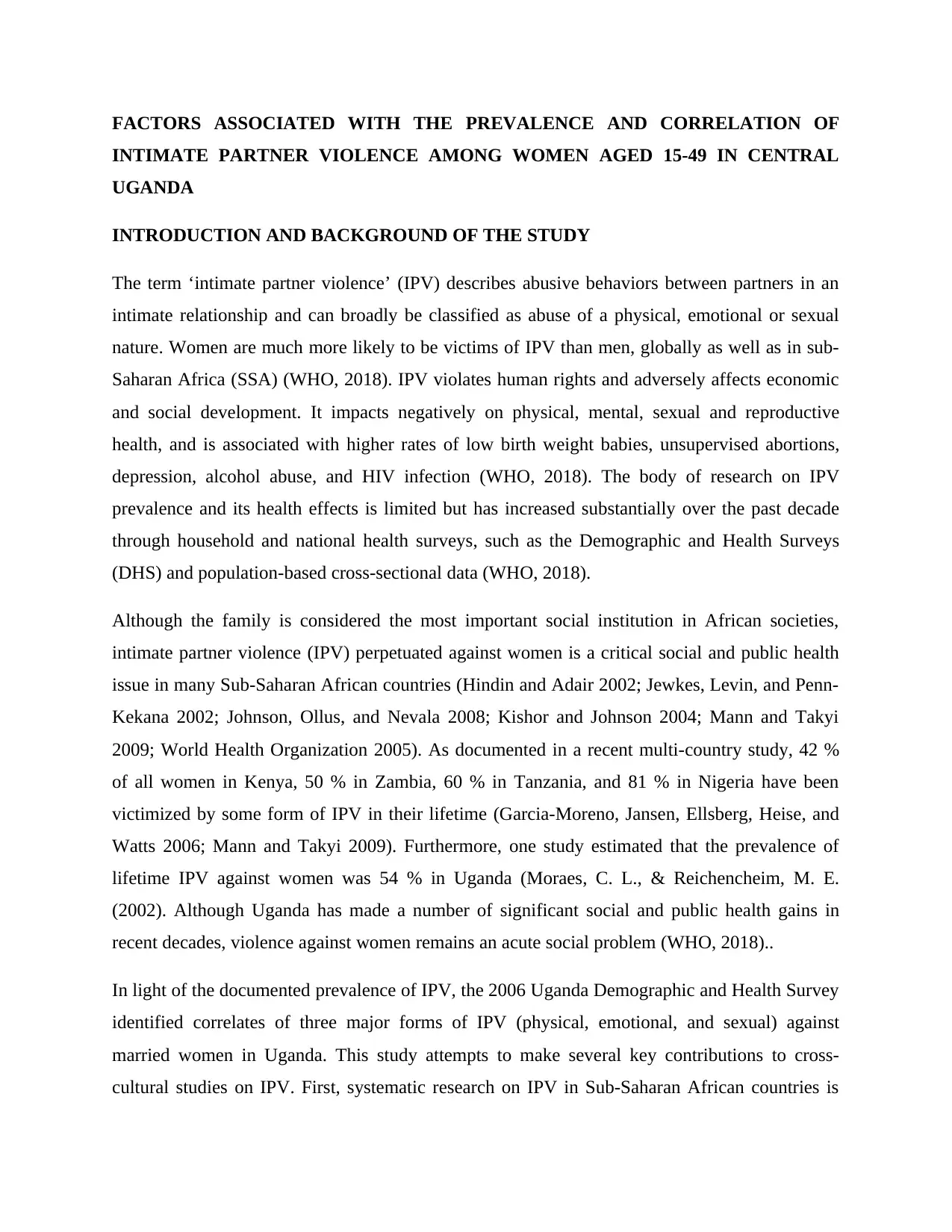
FACTORS ASSOCIATED WITH THE PREVALENCE AND CORRELATION OF
INTIMATE PARTNER VIOLENCE AMONG WOMEN AGED 15-49 IN CENTRAL
UGANDA
INTRODUCTION AND BACKGROUND OF THE STUDY
The term ‘intimate partner violence’ (IPV) describes abusive behaviors between partners in an
intimate relationship and can broadly be classified as abuse of a physical, emotional or sexual
nature. Women are much more likely to be victims of IPV than men, globally as well as in sub-
Saharan Africa (SSA) (WHO, 2018). IPV violates human rights and adversely affects economic
and social development. It impacts negatively on physical, mental, sexual and reproductive
health, and is associated with higher rates of low birth weight babies, unsupervised abortions,
depression, alcohol abuse, and HIV infection (WHO, 2018). The body of research on IPV
prevalence and its health effects is limited but has increased substantially over the past decade
through household and national health surveys, such as the Demographic and Health Surveys
(DHS) and population-based cross-sectional data (WHO, 2018).
Although the family is considered the most important social institution in African societies,
intimate partner violence (IPV) perpetuated against women is a critical social and public health
issue in many Sub-Saharan African countries (Hindin and Adair 2002; Jewkes, Levin, and Penn-
Kekana 2002; Johnson, Ollus, and Nevala 2008; Kishor and Johnson 2004; Mann and Takyi
2009; World Health Organization 2005). As documented in a recent multi-country study, 42 %
of all women in Kenya, 50 % in Zambia, 60 % in Tanzania, and 81 % in Nigeria have been
victimized by some form of IPV in their lifetime (Garcia-Moreno, Jansen, Ellsberg, Heise, and
Watts 2006; Mann and Takyi 2009). Furthermore, one study estimated that the prevalence of
lifetime IPV against women was 54 % in Uganda (Moraes, C. L., & Reichencheim, M. E.
(2002). Although Uganda has made a number of significant social and public health gains in
recent decades, violence against women remains an acute social problem (WHO, 2018)..
In light of the documented prevalence of IPV, the 2006 Uganda Demographic and Health Survey
identified correlates of three major forms of IPV (physical, emotional, and sexual) against
married women in Uganda. This study attempts to make several key contributions to cross-
cultural studies on IPV. First, systematic research on IPV in Sub-Saharan African countries is
INTIMATE PARTNER VIOLENCE AMONG WOMEN AGED 15-49 IN CENTRAL
UGANDA
INTRODUCTION AND BACKGROUND OF THE STUDY
The term ‘intimate partner violence’ (IPV) describes abusive behaviors between partners in an
intimate relationship and can broadly be classified as abuse of a physical, emotional or sexual
nature. Women are much more likely to be victims of IPV than men, globally as well as in sub-
Saharan Africa (SSA) (WHO, 2018). IPV violates human rights and adversely affects economic
and social development. It impacts negatively on physical, mental, sexual and reproductive
health, and is associated with higher rates of low birth weight babies, unsupervised abortions,
depression, alcohol abuse, and HIV infection (WHO, 2018). The body of research on IPV
prevalence and its health effects is limited but has increased substantially over the past decade
through household and national health surveys, such as the Demographic and Health Surveys
(DHS) and population-based cross-sectional data (WHO, 2018).
Although the family is considered the most important social institution in African societies,
intimate partner violence (IPV) perpetuated against women is a critical social and public health
issue in many Sub-Saharan African countries (Hindin and Adair 2002; Jewkes, Levin, and Penn-
Kekana 2002; Johnson, Ollus, and Nevala 2008; Kishor and Johnson 2004; Mann and Takyi
2009; World Health Organization 2005). As documented in a recent multi-country study, 42 %
of all women in Kenya, 50 % in Zambia, 60 % in Tanzania, and 81 % in Nigeria have been
victimized by some form of IPV in their lifetime (Garcia-Moreno, Jansen, Ellsberg, Heise, and
Watts 2006; Mann and Takyi 2009). Furthermore, one study estimated that the prevalence of
lifetime IPV against women was 54 % in Uganda (Moraes, C. L., & Reichencheim, M. E.
(2002). Although Uganda has made a number of significant social and public health gains in
recent decades, violence against women remains an acute social problem (WHO, 2018)..
In light of the documented prevalence of IPV, the 2006 Uganda Demographic and Health Survey
identified correlates of three major forms of IPV (physical, emotional, and sexual) against
married women in Uganda. This study attempts to make several key contributions to cross-
cultural studies on IPV. First, systematic research on IPV in Sub-Saharan African countries is
Paraphrase This Document
Need a fresh take? Get an instant paraphrase of this document with our AI Paraphraser
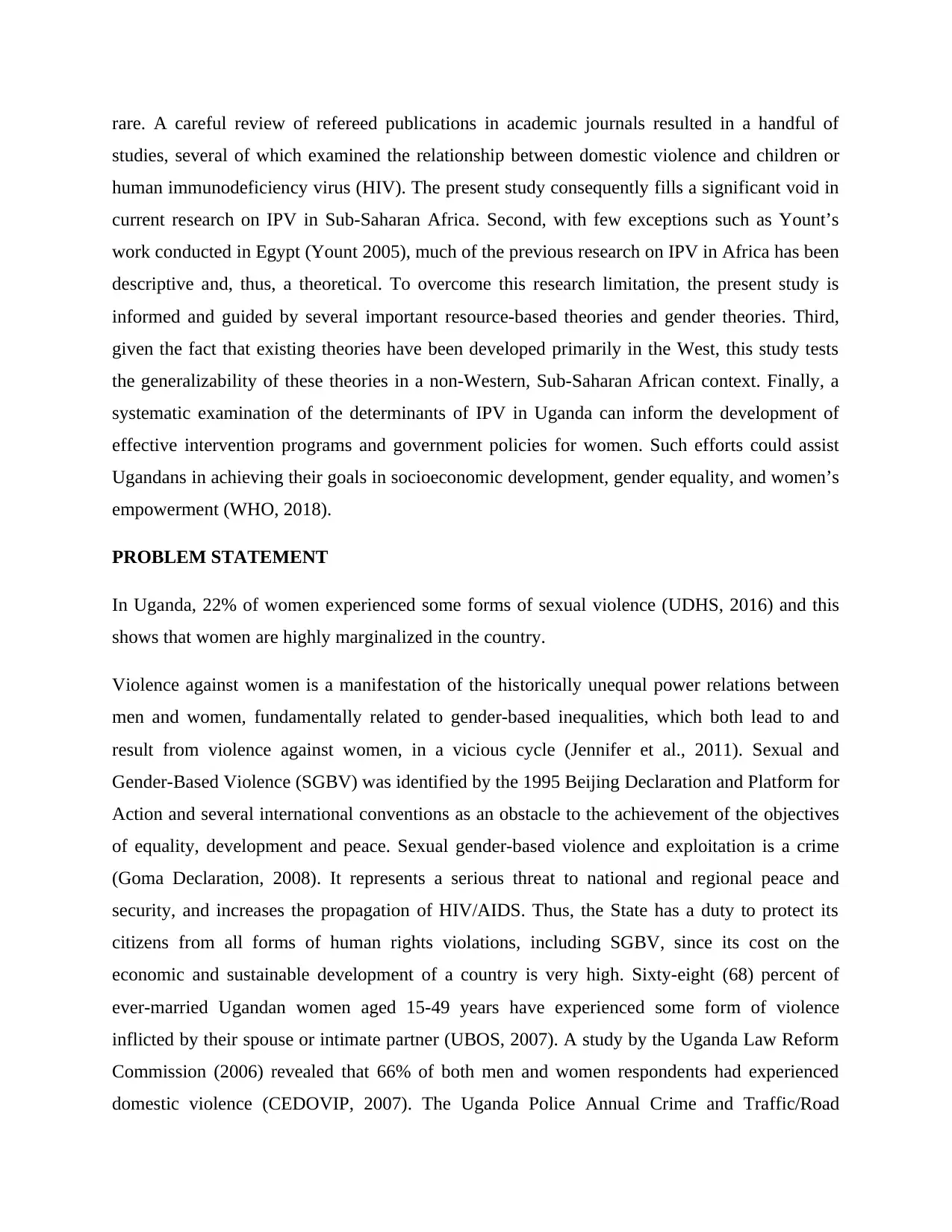
rare. A careful review of refereed publications in academic journals resulted in a handful of
studies, several of which examined the relationship between domestic violence and children or
human immunodeficiency virus (HIV). The present study consequently fills a significant void in
current research on IPV in Sub-Saharan Africa. Second, with few exceptions such as Yount’s
work conducted in Egypt (Yount 2005), much of the previous research on IPV in Africa has been
descriptive and, thus, a theoretical. To overcome this research limitation, the present study is
informed and guided by several important resource-based theories and gender theories. Third,
given the fact that existing theories have been developed primarily in the West, this study tests
the generalizability of these theories in a non-Western, Sub-Saharan African context. Finally, a
systematic examination of the determinants of IPV in Uganda can inform the development of
effective intervention programs and government policies for women. Such efforts could assist
Ugandans in achieving their goals in socioeconomic development, gender equality, and women’s
empowerment (WHO, 2018).
PROBLEM STATEMENT
In Uganda, 22% of women experienced some forms of sexual violence (UDHS, 2016) and this
shows that women are highly marginalized in the country.
Violence against women is a manifestation of the historically unequal power relations between
men and women, fundamentally related to gender-based inequalities, which both lead to and
result from violence against women, in a vicious cycle (Jennifer et al., 2011). Sexual and
Gender-Based Violence (SGBV) was identified by the 1995 Beijing Declaration and Platform for
Action and several international conventions as an obstacle to the achievement of the objectives
of equality, development and peace. Sexual gender-based violence and exploitation is a crime
(Goma Declaration, 2008). It represents a serious threat to national and regional peace and
security, and increases the propagation of HIV/AIDS. Thus, the State has a duty to protect its
citizens from all forms of human rights violations, including SGBV, since its cost on the
economic and sustainable development of a country is very high. Sixty-eight (68) percent of
ever-married Ugandan women aged 15-49 years have experienced some form of violence
inflicted by their spouse or intimate partner (UBOS, 2007). A study by the Uganda Law Reform
Commission (2006) revealed that 66% of both men and women respondents had experienced
domestic violence (CEDOVIP, 2007). The Uganda Police Annual Crime and Traffic/Road
studies, several of which examined the relationship between domestic violence and children or
human immunodeficiency virus (HIV). The present study consequently fills a significant void in
current research on IPV in Sub-Saharan Africa. Second, with few exceptions such as Yount’s
work conducted in Egypt (Yount 2005), much of the previous research on IPV in Africa has been
descriptive and, thus, a theoretical. To overcome this research limitation, the present study is
informed and guided by several important resource-based theories and gender theories. Third,
given the fact that existing theories have been developed primarily in the West, this study tests
the generalizability of these theories in a non-Western, Sub-Saharan African context. Finally, a
systematic examination of the determinants of IPV in Uganda can inform the development of
effective intervention programs and government policies for women. Such efforts could assist
Ugandans in achieving their goals in socioeconomic development, gender equality, and women’s
empowerment (WHO, 2018).
PROBLEM STATEMENT
In Uganda, 22% of women experienced some forms of sexual violence (UDHS, 2016) and this
shows that women are highly marginalized in the country.
Violence against women is a manifestation of the historically unequal power relations between
men and women, fundamentally related to gender-based inequalities, which both lead to and
result from violence against women, in a vicious cycle (Jennifer et al., 2011). Sexual and
Gender-Based Violence (SGBV) was identified by the 1995 Beijing Declaration and Platform for
Action and several international conventions as an obstacle to the achievement of the objectives
of equality, development and peace. Sexual gender-based violence and exploitation is a crime
(Goma Declaration, 2008). It represents a serious threat to national and regional peace and
security, and increases the propagation of HIV/AIDS. Thus, the State has a duty to protect its
citizens from all forms of human rights violations, including SGBV, since its cost on the
economic and sustainable development of a country is very high. Sixty-eight (68) percent of
ever-married Ugandan women aged 15-49 years have experienced some form of violence
inflicted by their spouse or intimate partner (UBOS, 2007). A study by the Uganda Law Reform
Commission (2006) revealed that 66% of both men and women respondents had experienced
domestic violence (CEDOVIP, 2007). The Uganda Police Annual Crime and Traffic/Road
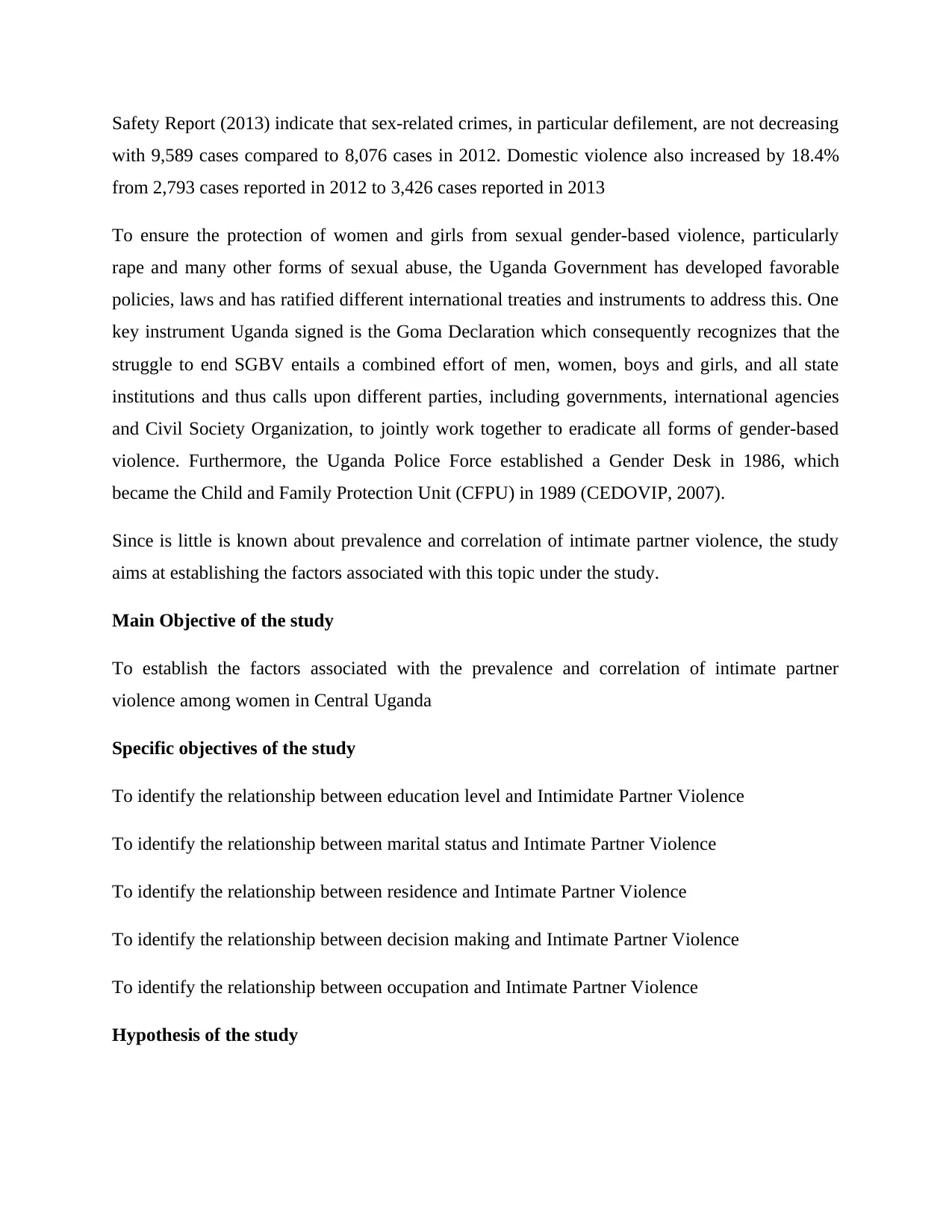
Safety Report (2013) indicate that sex-related crimes, in particular defilement, are not decreasing
with 9,589 cases compared to 8,076 cases in 2012. Domestic violence also increased by 18.4%
from 2,793 cases reported in 2012 to 3,426 cases reported in 2013
To ensure the protection of women and girls from sexual gender-based violence, particularly
rape and many other forms of sexual abuse, the Uganda Government has developed favorable
policies, laws and has ratified different international treaties and instruments to address this. One
key instrument Uganda signed is the Goma Declaration which consequently recognizes that the
struggle to end SGBV entails a combined effort of men, women, boys and girls, and all state
institutions and thus calls upon different parties, including governments, international agencies
and Civil Society Organization, to jointly work together to eradicate all forms of gender-based
violence. Furthermore, the Uganda Police Force established a Gender Desk in 1986, which
became the Child and Family Protection Unit (CFPU) in 1989 (CEDOVIP, 2007).
Since is little is known about prevalence and correlation of intimate partner violence, the study
aims at establishing the factors associated with this topic under the study.
Main Objective of the study
To establish the factors associated with the prevalence and correlation of intimate partner
violence among women in Central Uganda
Specific objectives of the study
To identify the relationship between education level and Intimidate Partner Violence
To identify the relationship between marital status and Intimate Partner Violence
To identify the relationship between residence and Intimate Partner Violence
To identify the relationship between decision making and Intimate Partner Violence
To identify the relationship between occupation and Intimate Partner Violence
Hypothesis of the study
with 9,589 cases compared to 8,076 cases in 2012. Domestic violence also increased by 18.4%
from 2,793 cases reported in 2012 to 3,426 cases reported in 2013
To ensure the protection of women and girls from sexual gender-based violence, particularly
rape and many other forms of sexual abuse, the Uganda Government has developed favorable
policies, laws and has ratified different international treaties and instruments to address this. One
key instrument Uganda signed is the Goma Declaration which consequently recognizes that the
struggle to end SGBV entails a combined effort of men, women, boys and girls, and all state
institutions and thus calls upon different parties, including governments, international agencies
and Civil Society Organization, to jointly work together to eradicate all forms of gender-based
violence. Furthermore, the Uganda Police Force established a Gender Desk in 1986, which
became the Child and Family Protection Unit (CFPU) in 1989 (CEDOVIP, 2007).
Since is little is known about prevalence and correlation of intimate partner violence, the study
aims at establishing the factors associated with this topic under the study.
Main Objective of the study
To establish the factors associated with the prevalence and correlation of intimate partner
violence among women in Central Uganda
Specific objectives of the study
To identify the relationship between education level and Intimidate Partner Violence
To identify the relationship between marital status and Intimate Partner Violence
To identify the relationship between residence and Intimate Partner Violence
To identify the relationship between decision making and Intimate Partner Violence
To identify the relationship between occupation and Intimate Partner Violence
Hypothesis of the study
⊘ This is a preview!⊘
Do you want full access?
Subscribe today to unlock all pages.

Trusted by 1+ million students worldwide
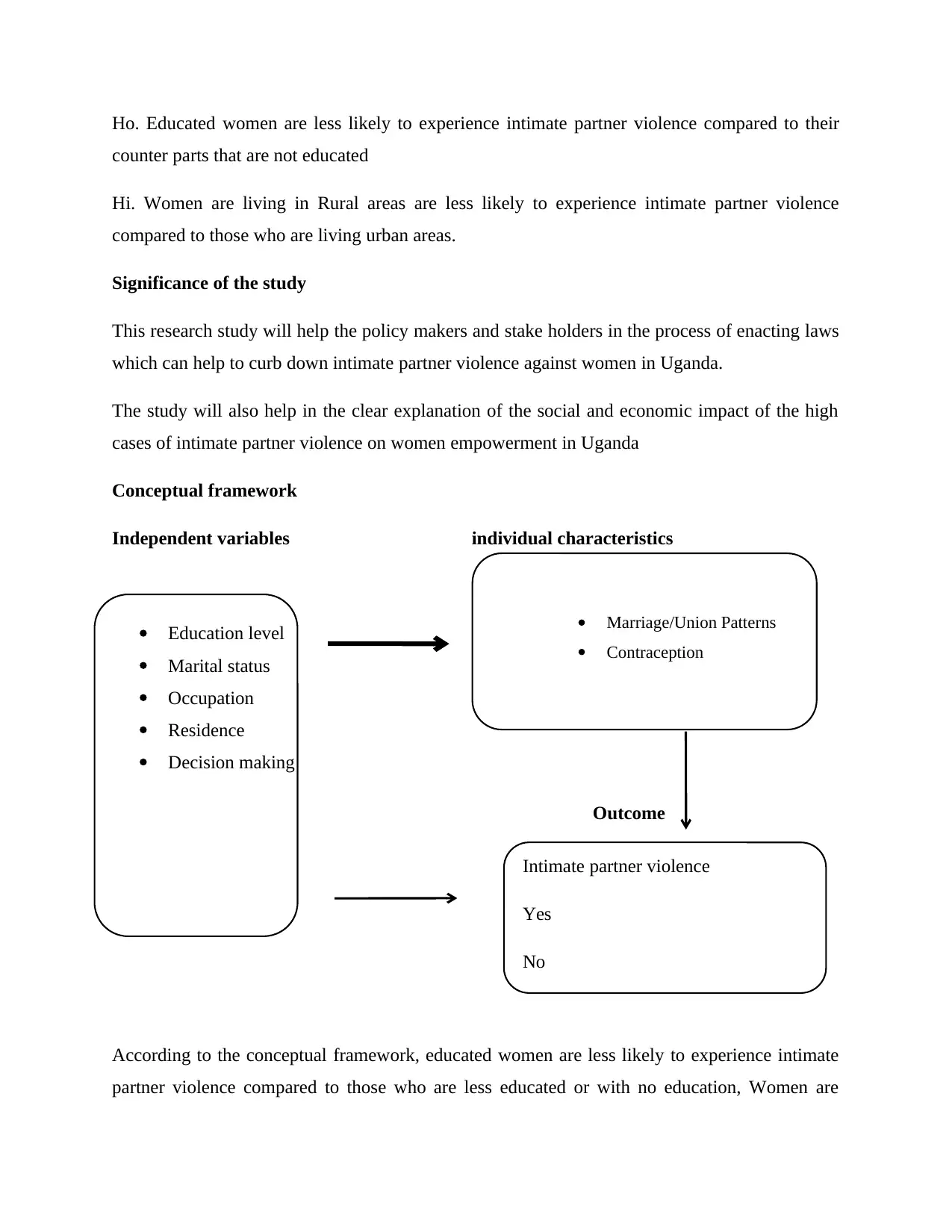
Ho. Educated women are less likely to experience intimate partner violence compared to their
counter parts that are not educated
Hi. Women are living in Rural areas are less likely to experience intimate partner violence
compared to those who are living urban areas.
Significance of the study
This research study will help the policy makers and stake holders in the process of enacting laws
which can help to curb down intimate partner violence against women in Uganda.
The study will also help in the clear explanation of the social and economic impact of the high
cases of intimate partner violence on women empowerment in Uganda
Conceptual framework
Independent variables individual characteristics
Education level
Marital status
Occupation
Residence
Decision making
Outcome
According to the conceptual framework, educated women are less likely to experience intimate
partner violence compared to those who are less educated or with no education, Women are
Marriage/Union Patterns
Contraception
Intimate partner violence
Yes
No
counter parts that are not educated
Hi. Women are living in Rural areas are less likely to experience intimate partner violence
compared to those who are living urban areas.
Significance of the study
This research study will help the policy makers and stake holders in the process of enacting laws
which can help to curb down intimate partner violence against women in Uganda.
The study will also help in the clear explanation of the social and economic impact of the high
cases of intimate partner violence on women empowerment in Uganda
Conceptual framework
Independent variables individual characteristics
Education level
Marital status
Occupation
Residence
Decision making
Outcome
According to the conceptual framework, educated women are less likely to experience intimate
partner violence compared to those who are less educated or with no education, Women are
Marriage/Union Patterns
Contraception
Intimate partner violence
Yes
No
Paraphrase This Document
Need a fresh take? Get an instant paraphrase of this document with our AI Paraphraser
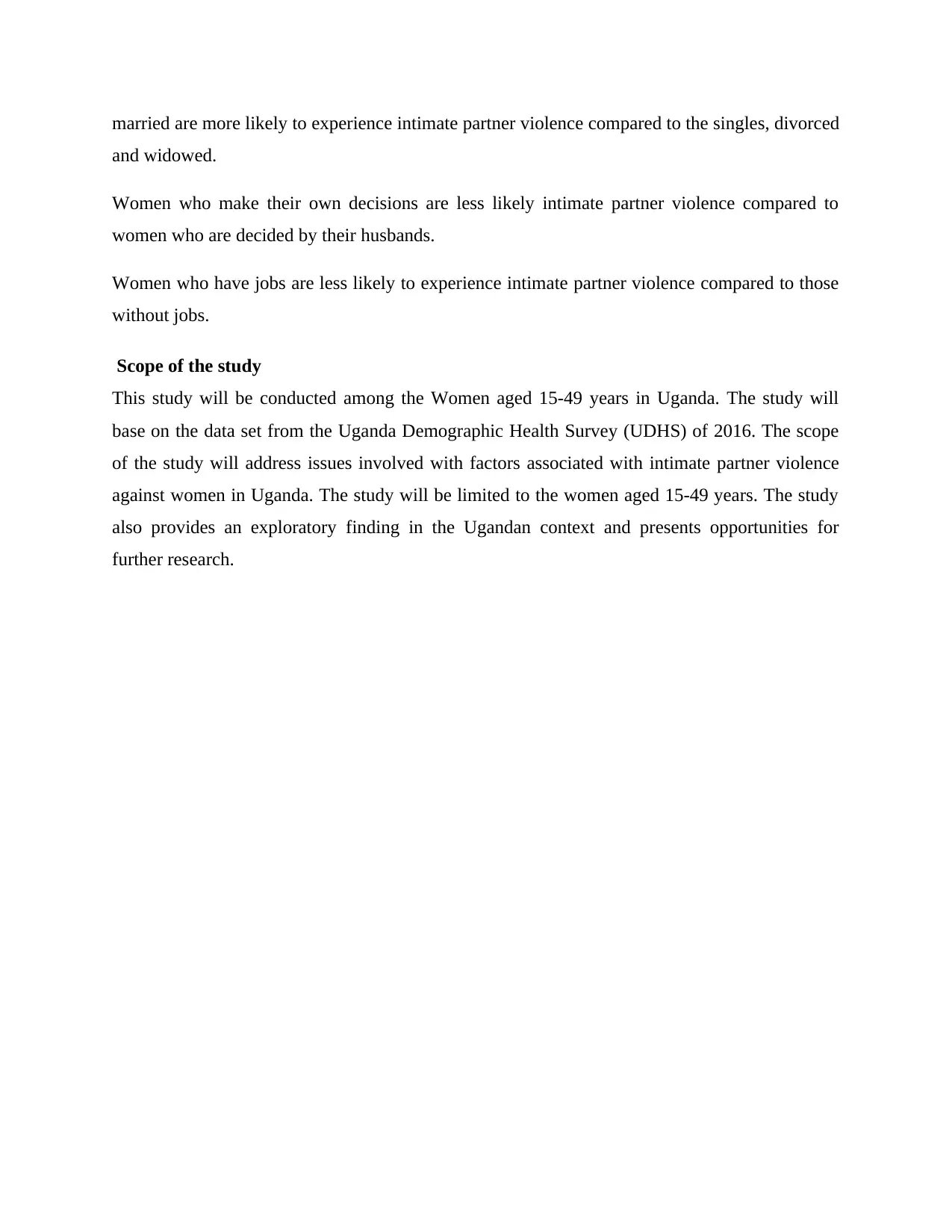
married are more likely to experience intimate partner violence compared to the singles, divorced
and widowed.
Women who make their own decisions are less likely intimate partner violence compared to
women who are decided by their husbands.
Women who have jobs are less likely to experience intimate partner violence compared to those
without jobs.
Scope of the study
This study will be conducted among the Women aged 15-49 years in Uganda. The study will
base on the data set from the Uganda Demographic Health Survey (UDHS) of 2016. The scope
of the study will address issues involved with factors associated with intimate partner violence
against women in Uganda. The study will be limited to the women aged 15-49 years. The study
also provides an exploratory finding in the Ugandan context and presents opportunities for
further research.
and widowed.
Women who make their own decisions are less likely intimate partner violence compared to
women who are decided by their husbands.
Women who have jobs are less likely to experience intimate partner violence compared to those
without jobs.
Scope of the study
This study will be conducted among the Women aged 15-49 years in Uganda. The study will
base on the data set from the Uganda Demographic Health Survey (UDHS) of 2016. The scope
of the study will address issues involved with factors associated with intimate partner violence
against women in Uganda. The study will be limited to the women aged 15-49 years. The study
also provides an exploratory finding in the Ugandan context and presents opportunities for
further research.
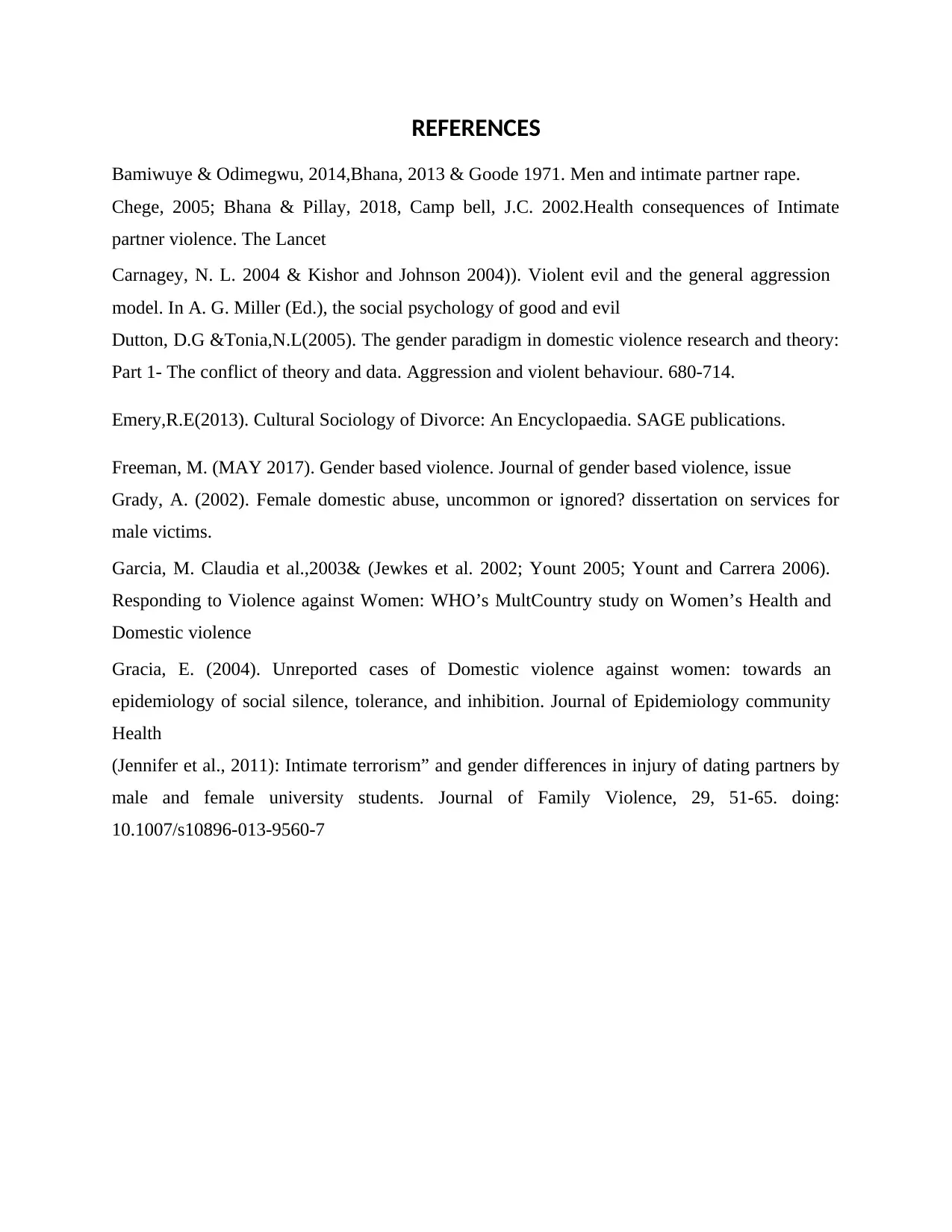
REFERENCES
Bamiwuye & Odimegwu, 2014,Bhana, 2013 & Goode 1971. Men and intimate partner rape.
Chege, 2005; Bhana & Pillay, 2018, Camp bell, J.C. 2002.Health consequences of Intimate
partner violence. The Lancet
Carnagey, N. L. 2004 & Kishor and Johnson 2004)). Violent evil and the general aggression
model. In A. G. Miller (Ed.), the social psychology of good and evil
Dutton, D.G &Tonia,N.L(2005). The gender paradigm in domestic violence research and theory:
Part 1- The conflict of theory and data. Aggression and violent behaviour. 680-714.
Emery,R.E(2013). Cultural Sociology of Divorce: An Encyclopaedia. SAGE publications.
Freeman, M. (MAY 2017). Gender based violence. Journal of gender based violence, issue
Grady, A. (2002). Female domestic abuse, uncommon or ignored? dissertation on services for
male victims.
Garcia, M. Claudia et al.,2003& (Jewkes et al. 2002; Yount 2005; Yount and Carrera 2006).
Responding to Violence against Women: WHO’s MultCountry study on Women’s Health and
Domestic violence
Gracia, E. (2004). Unreported cases of Domestic violence against women: towards an
epidemiology of social silence, tolerance, and inhibition. Journal of Epidemiology community
Health
(Jennifer et al., 2011): Intimate terrorism” and gender differences in injury of dating partners by
male and female university students. Journal of Family Violence, 29, 51-65. doing:
10.1007/s10896-013-9560-7
Bamiwuye & Odimegwu, 2014,Bhana, 2013 & Goode 1971. Men and intimate partner rape.
Chege, 2005; Bhana & Pillay, 2018, Camp bell, J.C. 2002.Health consequences of Intimate
partner violence. The Lancet
Carnagey, N. L. 2004 & Kishor and Johnson 2004)). Violent evil and the general aggression
model. In A. G. Miller (Ed.), the social psychology of good and evil
Dutton, D.G &Tonia,N.L(2005). The gender paradigm in domestic violence research and theory:
Part 1- The conflict of theory and data. Aggression and violent behaviour. 680-714.
Emery,R.E(2013). Cultural Sociology of Divorce: An Encyclopaedia. SAGE publications.
Freeman, M. (MAY 2017). Gender based violence. Journal of gender based violence, issue
Grady, A. (2002). Female domestic abuse, uncommon or ignored? dissertation on services for
male victims.
Garcia, M. Claudia et al.,2003& (Jewkes et al. 2002; Yount 2005; Yount and Carrera 2006).
Responding to Violence against Women: WHO’s MultCountry study on Women’s Health and
Domestic violence
Gracia, E. (2004). Unreported cases of Domestic violence against women: towards an
epidemiology of social silence, tolerance, and inhibition. Journal of Epidemiology community
Health
(Jennifer et al., 2011): Intimate terrorism” and gender differences in injury of dating partners by
male and female university students. Journal of Family Violence, 29, 51-65. doing:
10.1007/s10896-013-9560-7
⊘ This is a preview!⊘
Do you want full access?
Subscribe today to unlock all pages.

Trusted by 1+ million students worldwide
1 out of 6
Related Documents
Your All-in-One AI-Powered Toolkit for Academic Success.
+13062052269
info@desklib.com
Available 24*7 on WhatsApp / Email
![[object Object]](/_next/static/media/star-bottom.7253800d.svg)
Unlock your academic potential
Copyright © 2020–2025 A2Z Services. All Rights Reserved. Developed and managed by ZUCOL.



![Research Proposal on Domestic Violence in Jamaica, [University Name]](/_next/image/?url=https%3A%2F%2Fdesklib.com%2Fmedia%2Fimages%2Fvm%2F9409e01f7b7b4bbcab39dc5b8f65bc8f.jpg&w=256&q=75)

